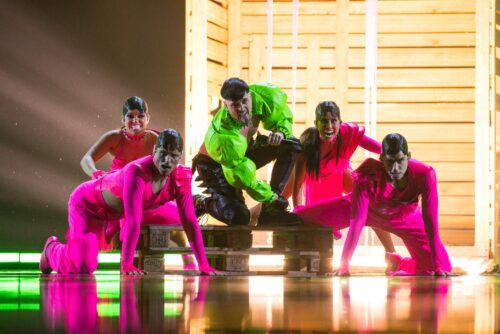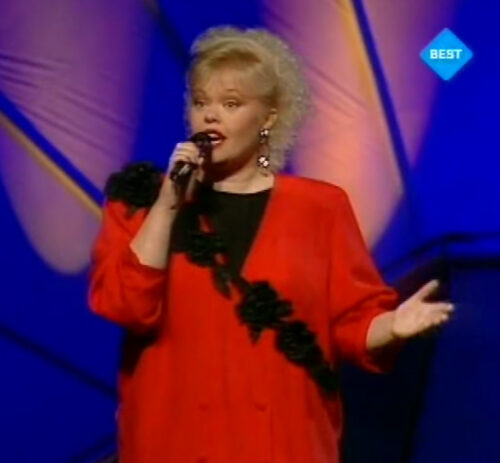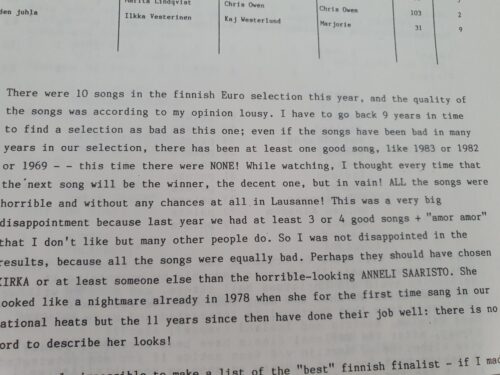We know a lot about Eurovision and we want to share this knowledge with you! Therefore we’d like to bring you a blast from the past. Today: Anneli Saaristo, who represented Finland in 1989.
Finland in the Eurovision Song Contest
Finland’s participation in the Eurovision Song Contest has been marked by a variety of performances and results since the country’s debut in the competition in 1961. Over the years, Finland has experienced both highs and lows. Finland’s initial years in Eurovision were tough. For many years, the nation struggled to make a significant impact on the scoreboard. They even scored ‘nul points’ (zero points) in 1963, 1965, and 1982. Their best score was a 6th place for Marion Rung and her “Tom Tom Tom” in 1973.
Finland’s most iconic moment in the contest came in 2006 when the hard rock band Lordi won with the song “Hard Rock Hallelujah”. Not only did this victory mark Finland’s first and, so far, only win in the contest, but it was also historic because Lordi was a hard rock band with a monster image – quite a departure from the usual Eurovision acts.
This year, Finland reached the top again, winning the televote and reaching a second place overall. Again, the song “Cha-cha-cha” and Käärijä’s performance faced a unique sound and performance.

Photo: Corinne Cumming/EBU
Euroviisut, the national final
In those days, the national selection was called Euroviisut. Ten songs competed in the contest that was held on February 4th in the Kulttuuritalo in Helsinki. Note that Anneli Saaristo sang two songs in the competition! Two songs are not in Finnish but in Swedish. The entire show can be watched here.
- Oi Äiti Maa, sung by Anneli Saaristo, 74 pts, 3rd
- Kan Det Vara Kärlek?, Mervi Hiltunen, 72 pts, 4th
- Hiljaisuutta, Kirka, 62 pts, 5th
- Rauhaton Sydän, Meiju Suvas, 24 pts, 10th
- Huominen Eurooppa, Tanjalotta Räikkä, 39 pts, 8th
- La Dolce Vita, Anneli Saaristo, 110 pts, 1st
- Minä Olen Muistanut, Kim Lönholm, 52 pts, 7th
- Rakkauden Laulut, Sonja Lumme, 62 pts, 5th
- Vad Finns Kvar, Cris Owen, 103 pts, 2nd
- Kahden Juhla, Marjorie, 31 pts, 9th
Anneli Saaristo
In the early 1970s, Saaristo participated in pop song contests. Throughout the decade, she worked as the soloist for a dance orchestra and mainly recorded cover versions of pop songs. In the spring of 1978, Saaristo competed in the Finnish Eurovision qualifiers Euroviisut with the song “Sinun Kanssasi, Sinua Ilman,” which became her first hit. Her next recording was “Aamulla Rakkaani Näin,” which Lea Laven had performed in the same qualifiers.
Saaristo’s first album, “Aina Aika Rakkauden,” was released in 1980. Published by a small record company, the album was a commercial disappointment. In 1982, Saaristo participated in the Autumn Tune competition with the song “Tyhjät Sanat” and in the 1984 Euroviisut with “Sä Liian Paljon Vaadit,” finishing third. Both songs were hits, and her subsequent albums sold better than the first.
In the fall of 1988, Saaristo received a press award in the Autumn Tune for her song “Taivaspaikka.” In 1989, she performed in the Eurovision qualifiers with the songs “Oi Äiti Maa” and “La Dolce Vita,” the latter winning. At the Eurovision Song Contest in Lausanne, “La Dolce Vita” placed seventh. The “La Dolce Vita” album achieved gold status.
Some of Saaristo’s most renowned songs include “Viimeinen Känni,” “Evakon Laulu,” “Päättyneet Juhlat,” “Appelsiinipuita Aavikkoon,” and “Kypsän Naisen Blues.” In the project “Miten Enkeleitä Vietellään,” she interpreted Bertolt Brecht’s erotic poems alongside Monna Kamu and Liisa Tavi. In the 2000s, Saaristo participated in Rakkauden Kiertokulku concerts with Eija Kantola and Marjorie.
Saaristo has also acted, for instance, in Turku City Theater. In 2005, she appeared in Timo Koivusalo’s movie Kaksipäisen Kotkan Varjossa. That same year, she was nominated for the Iskelmä-Finlandia award. In 2011, Saaristo was granted an artist pension. In recent years, she has performed with pop singer Fredi on the “Fredi’s Guest” concert tour.

Controversy
When Anneli Saaristo took part in Euroviisut and won it, this was of course mentioned in the fan magazines. A Finnish reporter in one of the magazines wrote about Anneli: “She looked like a nightmare already in 1978 when she for the firs time sang in our national heats but the 11 years since then have done their job well: there is no word to describe her looks!”. The writer of the article apologized one magazine later; he explained the article was not a proper translation of a letter in Finnish, and was mixed up with another article, that should have been published.

La Dolce Vita
“La Dolce Vita” is perhaps one of the most iconic songs associated with Anneli Saaristo, especially on the international stage. It was Finland’s official entry to the Eurovision Song Contest in 1989. The title, which translates to “The Sweet Life” in Italian, captures the essence of living life to the fullest and enjoying its pleasures.
The song’s participation in Eurovision marked a significant moment for Finland. Competing in Lausanne, Switzerland, “La Dolce Vita” achieved a commendable 7th place finish. This placement was a notable achievement for Finland at that time.
The tune itself is melodious and catchy, combining traditional pop elements with a distinct Finnish touch. Anneli’s powerful voice and emotive rendition made the performance memorable, helping the song stand out amidst other competitors.
While “La Dolce Vita” may not have secured the top spot at Eurovision, it cemented its position as one of Anneli Saaristo’s most celebrated tracks. Following the contest, the song enjoyed considerable airplay and popularity in Finland and even gained recognition in various parts of Europe. The song’s success also contributed to Anneli’s continued prominence in Finnish music, further showcasing her versatility and talent.

